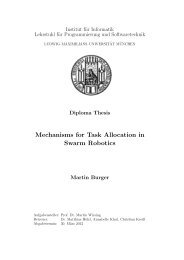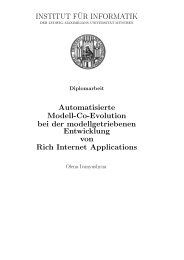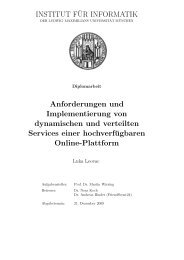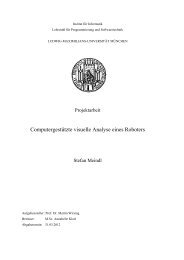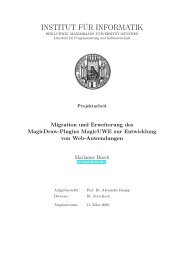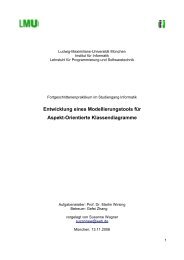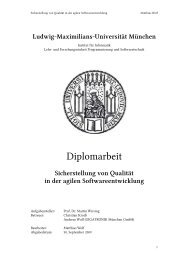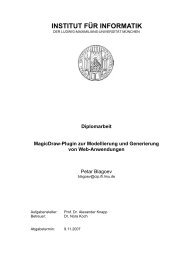institut f¨ur informatik - PST Thesis Management Interface - LMU
institut f¨ur informatik - PST Thesis Management Interface - LMU
institut f¨ur informatik - PST Thesis Management Interface - LMU
You also want an ePaper? Increase the reach of your titles
YUMPU automatically turns print PDFs into web optimized ePapers that Google loves.
4.1. Realization of GAUTOSAR<br />
Originally the first two of the described GAUTOSAR realization steps have only been conducted<br />
manually. These steps require a domain expert to simultaneously browse and compare<br />
the structure of multiple AUTOSAR metamodels and determine changes among them (step<br />
one), then build a generic metamodel (step two) based on its desired properties (which will<br />
be reflected in the API) and the types of changes that occurred.<br />
The advantage of the approach where the first two steps are conducted manually is that<br />
a human domain expert can instantly recognize change and its influence on the surrounding.<br />
This is due to a human’s ability to implicitly understand context [WSA02]. Furthermore, a<br />
human expert has an understanding of the semantics behind the data structure - in this case<br />
the principles governing model-based and object-oriented software development. An algorithm<br />
can essentially only base its decisions on the syntax of a data structure, which makes<br />
its understanding of context limited. Therefore, creating a generic metamodel is a relatively<br />
easy task for a human expert. The disadvantage of the manual approach is that the current<br />
AUTOSAR metamodels contain between 600 and 900 classes, which makes manual analysis<br />
an extremely complicated and time-consuming task. Moreover, each time a new AUTOSAR<br />
metamodel becomes available and also becomes supported in an Artop release, the process<br />
has to be repeated with consideration of all metamodels that are supported in the particular<br />
Artop release. This includes some or all of the previously supported metamodels and the<br />
new metamodel. However, a fully automated process might not produce results as good as<br />
the manual process due to the semantic gap in algorithmic data processing. The ideal approach<br />
will combine fast automated processing with the contextual knowledge of the human<br />
expert. This semi-automatic approach combines the advantages of both man and machine<br />
while excluding the disadvantages on both sides to the furthest possible extent.<br />
4.1.2. Automation of the GAUTOSAR realization process<br />
The first step of the GAUTOSAR realization process - comparison of version-specific AU-<br />
TOSAR metamodels - was automated in the DiffMap project - a preceding thesis at BMW<br />
Car IT. The results of the DiffMap project including improvements that were contributed<br />
in this thesis are presented in section 4.2. Automation of the second step - creation of the<br />
GAUTOSAR metamodel - is the subject of this thesis and is presented in section 4.3.<br />
The quality of the metamodel comparison result directly influences the quality of the created<br />
generic metamodel. The extent of the generic metamodel then determines the usability<br />
extent of the generic API. As explained in the previous section, automatic comparison cannot<br />
detect all types of changes that can occur between version-specific metamodels due to<br />
a semantic gap. Similarly, some types of changes cannot be automatically resolved by the<br />
engine that uses comparison information to create the generic metamodel (see section 2.3.2).<br />
In order to resolve such issues nevertheless and improve the quality of the generic API, the<br />
comparison result and the generic metamodel should include a possibility for manual intervention<br />
by a domain expert. The comparison result and the generic metamodel are both<br />
Ecore models (see section 2.2.1) that can be manipulated by hand in Eclipse.<br />
The third step is already automated. It involves using an EMF generator that has been<br />
customized for Artop with special JET templates (see section 2.2.3) to generate the desired<br />
result. The generator processes the GAUTOSAR metamodel that is enriched with<br />
39



